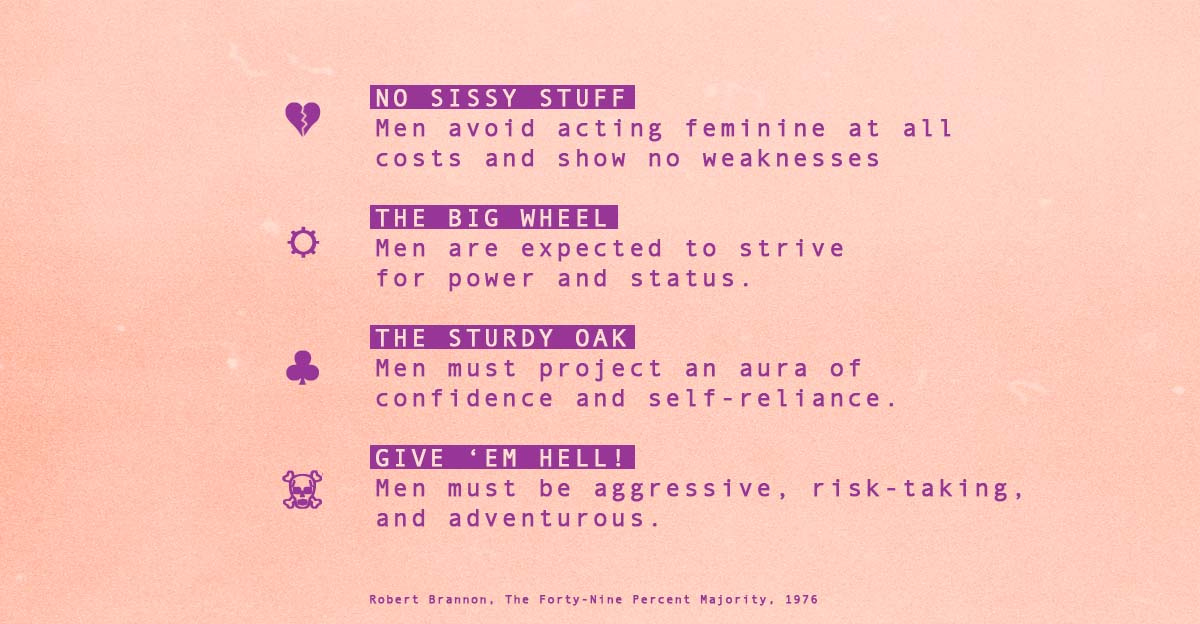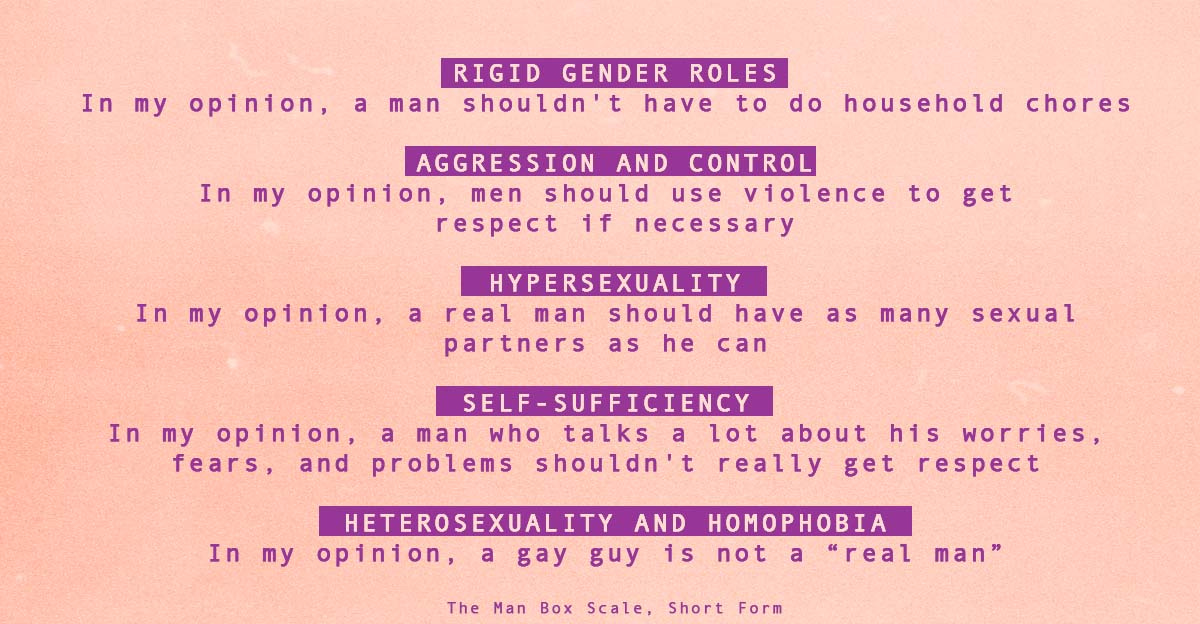Can You Measure Masculinity?
Details from a recent study that quantifies the harmful aspects of being a man

Warning: It's about to get nerdy. But in the best possible way…
"Masculine" is a word that's often used but hard to define. Yes, of course, you can Google it, and Merriam Webster will tell you that it means "having qualities appropriate to or usually associated with a man."
But that skin-deep explanation fails to answer two critical questions. First, what constitutes being a man?
For hundreds of years, philosophers, academics, and cultural critics alike have debated the relationship between sex and gender. Some have argued that critical psychological and behavioral differences between men and women are "hard-wired" in biology (genes, hormones, etc.). Others have made the case that they are learned through culture and experience, thus making these variations a social rather than a biological construct.
However, that issue merits an article entirely itself. So I'm going to set it aside for now and focus on the second question: What are the qualities associated with being a man?
Undoubtedly, we all have general ideas about this topic. However, that's precisely the problem. "Masculinity" often functions as a suitcase word into which one can pack all different kinds of meanings.
For example, I often argue that vulnerability is a sign of strength among male athletes. However, Fox sports commentator, Skip Bayless, would likely object to that statement. Just last week, he said suggested that Dallas Cowboys quarterback, Dak Prescott, demonstrated a failure in leadership when he spoke out about struggling with depression. 😡
(I'm simplifying here to deliver a point, but the details are worth reading).
These disagreements make the study of masculinity difficult. Which is why researchers have spent the last forty years proposing precise terminology for masculine qualities along with corresponding measurement tools.
Sociologist Robert Brannon was among the first in this group to take the amorphous concept of masculinity and break it down into distinct, observable traits. His book The Forty-Nine Percent Majority (published in 1976) presented the Brannon Masculinity Scale, a four-dimensional "blueprint of manhood."

Since then, other academics have parsed these pillars down further and proposed alternate masculinity indexes, each offering its own flair (ex. 1, ex. 2, ex. 3).
However, because an increasing number of studies now focus on the impact of "toxic masculinity" (note: academics generally avoid this term), the search continues for new and improved ways to observe it's associated qualities on a consistent and quantifiable scale.
Just last month, researchers at the University of Pittsburgh published a paper about the Man Box Scale, a measurement framework focused on precisely that end. When I asked one of the study's co-authors, Dr. Amber Hill, about the team's motivation, she said:
"There's a lot of attention focused on harmful masculinity…We know it exists and that it's problematic. [However we need] to pick specific items and validate them in a large data set, so that we can concretely evaluate how to drive change in health and policy."
The scale takes its name from the "Man Box," a term coined in the 90s by community educator, Paul Kivel, to describe the social pressures that men feel around adopting masculine behaviors and norms. (The idea was later popularized in a TED Talk by activist, Tony Porter).
Then, in 2017, Brazilian-based NGO, Promundo, and the men's grooming brand, AXE, adapted the concept into a 17-item questionnaire. The resulting survey* yielded essential insights into the lives of men. But it also required more evidence to be accepted as a measurement tool within the broader scientific community.
Enter Dr. Hill and the team at UPitt, who ran a variety of statistical analyses on that data set. I'll breeze through this part because it involves terms like "confirmatory factor analyses" 🤯. But suffice it to say that, after nixing** two the seventeen questions, the measurement framework does indeed appear to be an effective and reliable scale.
Now on the to the most interesting part. For easier implementation, Dr. Hill and her colleagues also developed and validated a short-form survey, which winnowed down the original to a mere 5-item questionnaire.

By understanding their attitudes toward the five statements above, you can tell a lot about different groups of men. As part of the validation process, the team demonstrated that the short-form survey also had significant associations with suicidal ideation, depression, and violence perpetration.
This suggests to me that, from a policy and communications perspective, we must isolate and confront each of these issues individually if we want to make an impact on men at large. It's a considerable effort to undertake, but with measurement tools like The Man Box Scale, at least we have somewhere to start.
I'm going to leave it there. However, considering this week's Mandate Letter was more academic in nature, I'd love to hear what you think.
Was this entry: Amazing | Good | Meh | Bad | Just Show Me A Cat GIF
Footnotes
*Men rate their feelings toward these statements using the 4-point Likert Scale: 1-strongly disagree to 4-strongly agree
**While reanalyzing the data, the UPitt determined that two of the 17-item questionnaire didn't track well against the construct of harmful masculinity because of differences in culture between the survey groups in the U.S., Mexico, and the U.K.
About The Mandate Letter
I use this newsletter as a journal to work through my ideas and collect examples of broader trends that reflect how masculinity is evolving in culture. I would very much appreciate your input.
If you come across interesting examples of this trend or others, please email me tips at Jason [@] jasonrogers.co. If you're reading this in your inbox, just hit reply, and your response will go directly to me.
Also, keep up with me on Twitter & Instagram or text me at 310-299-9363.




Wanted to add that Christian Lopez (former pro-baseball player) just did a really nice breakdown of the Dak Prescott / Skip Bayless issue mentioned above. https://podcasts.apple.com/us/podcast/behind-the-mask-ulinity/id1474423662
As an educator, I find this very interesting. Obviously, parents play a role in imparting healthy attitudes about gender, but so do teachers. Children spend a lot of time in school. Any research that leads us in encouraging the growth of kind, empathic humans is valuable. And I certainly do not mean to imply this is only a male issue. It would be interesting to ask females those same questions. We are all in this together.